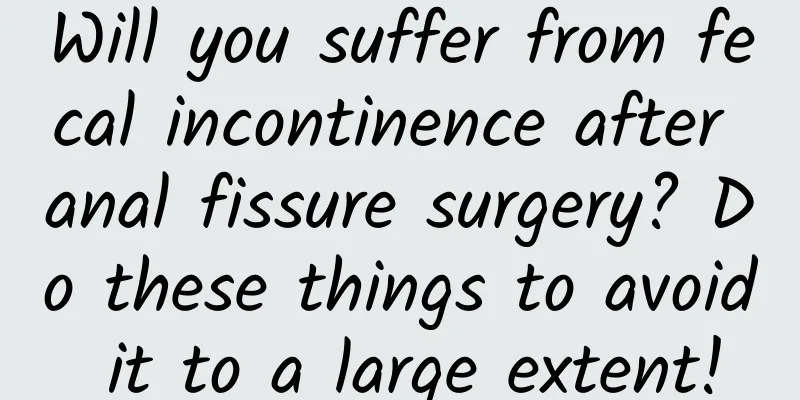Will you suffer from fecal incontinence after anal fissure surgery? Do these things to avoid it to a large extent!

|
Author: Wang Zhenbiao, Chief Physician, Beijing Century Altar Hospital, Capital Medical University Reviewer: Fan Xueshun, Chief Physician, China-Japan Friendship Hospital Most anal fissures do not require surgery and can be treated conservatively. When the condition is more serious and chronic anal fissures form, such as sentinel piles, hypertrophy of anal papillae, anal fistulas, and anal crypt infections, surgical treatment is required. Figure 1 Original copyright image, no permission to reprint 1. What are the surgical treatments for anal fissure? There are many surgical methods for anal fissure, the most common ones are: First, anal dilation therapy. Anal dilation therapy is relatively simple and is mainly used for primary anal fissures, that is, sentinel piles are very small, there is no hypertrophy of the anal papilla, and there is no anal crypt infection. Anal dilation therapy can be used. Anal dilation therapy involves dilating the anus under local infiltration anesthesia. Four fingers, the index and middle fingers of both hands, are inserted to dilate the anus for about four minutes to partially relax the anal sphincter. The anal lacerations in the front and back may become larger, and there may be a small amount of bleeding. Basically, the effect is achieved. Second, surgical resection. For example, if there is an ulcer in the local area, the ulcer must be removed; if there are sentinel piles, anal papilloma, or anal papillary hypertrophy, they must be removed; if there is an infection in the anal crypt, the infection focus must be removed together; the lower edge of the internal sphincter must be removed. There is a linea alba in the local anatomy of the anus. Above the linea alba is the lower edge of the internal sphincter, and below is the subcutaneous part of the external sphincter. If only the lower edge of the internal sphincter is cut, a depression will often form in the subcutaneous part of the external sphincter, which will not heal. Cutting off the subcutaneous part of the external sphincter as well can create a window for smooth drainage, and the wound will heal naturally. This is currently the most commonly used method. Anal fissures are caused by the narrowness of the anal canal and the narrow anatomical structure of the anus. During surgery, depending on the situation, the lower edge of the internal sphincter is cut relatively deeply. After the subcutaneous and superficial parts of the external sphincter are cut, a longitudinal incision and a transverse suture may be made to artificially enlarge the anus. For example, anal fissures formed after surgery have scars. Traditional surgery, anal dilation, and sphincter removal cannot solve the problem, so flap transplantation is needed. A one-time incision is made at the scar, cutting to the bottom of the scar, making a V-shaped incision, freeing the outer normal skin, artificially expanding the anal canal and rectum, and achieving the purpose of curing anal fissures. There are also superficial subcutaneous incisions, internal sphincter and external sphincter subcutaneous surgeries. There are many surgical methods. The doctor will choose the one that suits you based on your condition. The ultimate goal is to remove anal fissures and complications such as thickened distal membrane bands, enlarged anal papilloma, shallow fistulas or sentinel piles, and finally achieve recovery. 2. Will there be any sequelae after anal fissure surgery? Surgery itself is an injury. Anal fissure requires cutting the lower edge of the internal sphincter. If you cut too much and cut off the rest, there may be problems. After cutting off the lower edge of the internal sphincter, there is still the external sphincter. It is fine to cut off the subcutaneous part of the external sphincter, but if the shallow or deep part is cut, the anus may not close tightly or there may be overflow. Severe sphincter damage may cause difficulty in controlling bowel movements. After some surgeries, patients have to go to the bathroom immediately when they need to defecate and dare not go out for a walk. Wherever they go, they first have to see if there is a toilet nearby. After the wound has healed after surgery, if the above situation still occurs, you may need to do an electromyography or anal three-dimensional ultrasound to see if the sphincter is broken. Surgery may be needed to reconnect the sphincter, which is more complicated, so you must strictly follow the surgical standards for resection and choose a regular and professional hospital. Figure 2 Original copyright image, no permission to reprint Of course, an experienced doctor may change the surgical procedure according to the tightness of the anus and the thickness of the conjunctival band, which is more conducive to the patient's recovery. This needs to be gradually explored in clinical practice. For elderly and weak patients with anal fissures, less incision should be made; for young patients with very thick anal sphincters, a larger incision should be made. With postoperative follow-up, as long as the patient pays close attention to lifestyle and diet, there will generally be no problem. 3. What should I pay attention to after anal fissure surgery? For anal fissure, we believe that 30% treatment and 70% care are needed, and the postoperative recovery period is very critical. 3-7 days after surgery, antibiotics are infused during hospitalization to prevent infection, including sitz baths, physical therapy, and daily local disinfection and dressing changes. Because the surgery is an open wound, sutures are rarely required, and surface exudates and secretions are removed. Then, an anti-inflammatory and analgesic suppositories are inserted into the anus, some oil gauze strips are placed at the anus, and drugs to remove dead tissue and promote muscle regeneration are applied to allow the wound to heal naturally and eventually recover. In addition, after the operation, you should pay attention to a light diet, avoid spicy and irritating foods, and it is crucial to match coarse and fine grains to prevent constipation. For mild anal fissures, they will heal naturally in about a week after surgery, or even three to five days. We require continued medication to completely cure the disease. Old anal fissures are relatively serious and the wounds are very deep. The healing time is about 3-4 weeks. If combined with diabetes or hypoproteinemia, anemia, and immune system diseases, the healing time may be longer, requiring 4-6 weeks. After discharge from the hospital, you need to come for regular checkups. In some cases, false healing and fistula formation may occur after three to five weeks, and surgery may be required. The recovery period after anal fissure surgery is very critical, and includes diet, local fumigation and sitz bath, local dressing changes, physical therapy, and regular follow-up. Failure to do any of these may affect wound healing and lead to problems such as changes in anal function. |
<<: In addition to tremors, Parkinson's disease also requires attention to these symptoms!
Recommend
Reasons for light menstrual flow after abortion
Nowadays, more and more women are having abortion...
Can I have an abortion at four months of pregnancy?
Nowadays, many female friends, especially young f...
What to do if your vulva is itchy
As a modern woman, you not only have to take care...
Is it B-ultrasound or vaginal ultrasound to monitor ovulation?
Nowadays, women begin to actively check their ovu...
Pregnancy test paper shows one dark and one light, is it pregnant?
Pregnancy test strips are a method of testing whe...
Will I have an ectopic pregnancy if I have an IUD?
The IUD is a common contraceptive method. It is c...
What is a positive test for hydrogen peroxide?
We all know that hydrogen peroxide is a chemical ...
Is it normal to have a 7-day delay in menstruation?
Women have menstruation every month, and the norm...
Foods that make your farts smell more and more, I finally found them all! There is one category you would never expect...
Farts are big things, but if you fart in the wron...
Brown discharge at 38 weeks of pregnancy
Pregnancy is a process that every woman must go t...
The difference between miscarriage bleeding and menstruation
When miscarriage occurs, there will be bleeding, ...
Can drinking weakly alkaline mineral water help you give birth to a son? Don’t believe it anymore…
gossip "Drinking weak alkaline mineral water...
Is it normal to have more vaginal discharge before menstruation?
Leucorrhea is the most common female secretion. I...
Under what circumstances will the early pregnancy test paper show a false positive
Many women of childbearing age, if they have norm...
How many days after transplantation will early pregnancy symptoms appear?
There are indeed many couples in life today who c...









